Removing AI detection is reliable around 85% of the time. It’s a good idea to double-check with our AI detector to ensure no AI content remains, and fix any parts that might be overlooked. Simple texts might need more than one attempt.
Try Bypass Engine – it’s on us!
Using Bypass Engine’s advanced tool, you can easily get past AI content detectors. This helps your writing feel natural and human-like. Whether you’re using ChatGPT to write articles, essays, or help with creative projects, Bypass Engine adjusts your content. It removes signs it was written by AI but keeps the original meaning and quality.
The tool works quietly to tweak tone, structure, and wording. This makes your work sound like a real person wrote it, not a machine. It’s useful for students, bloggers, marketers, and professionals who want to keep their work original and undetected by AI-checking software.
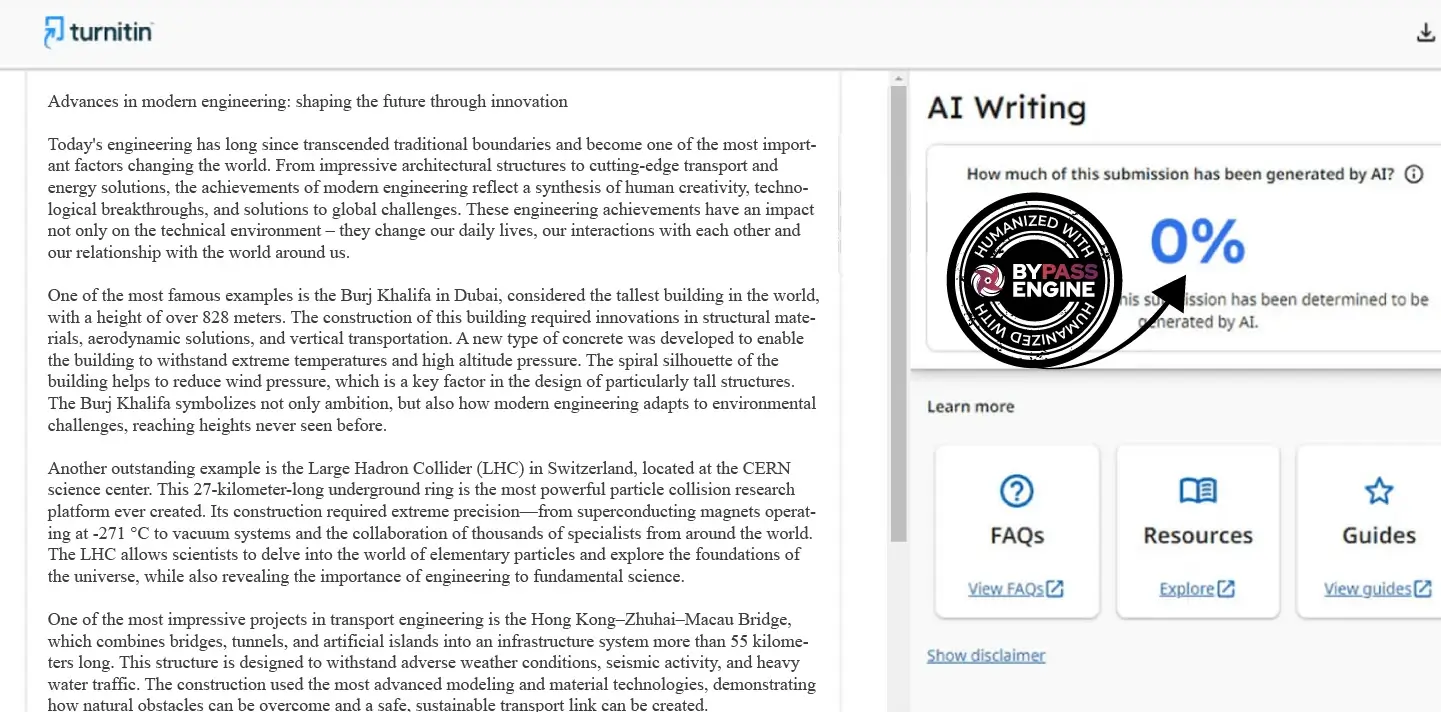
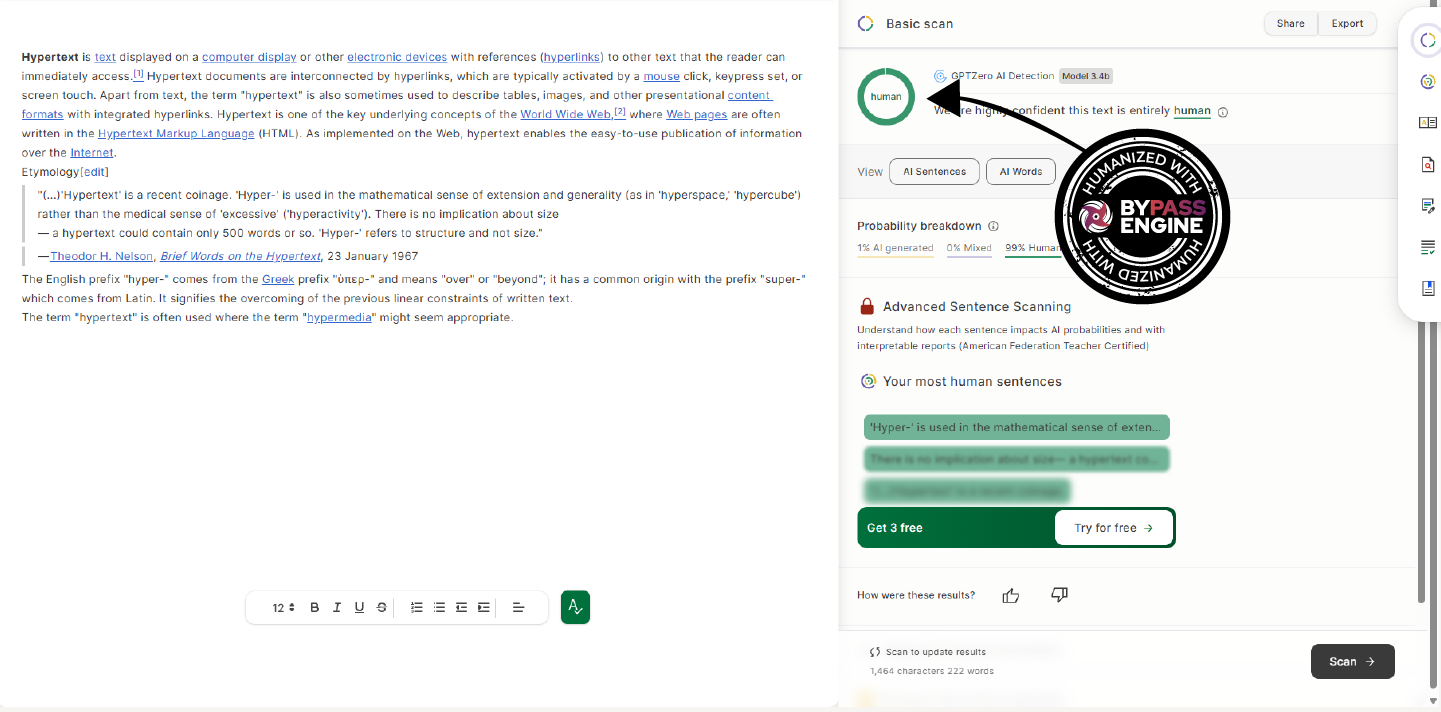
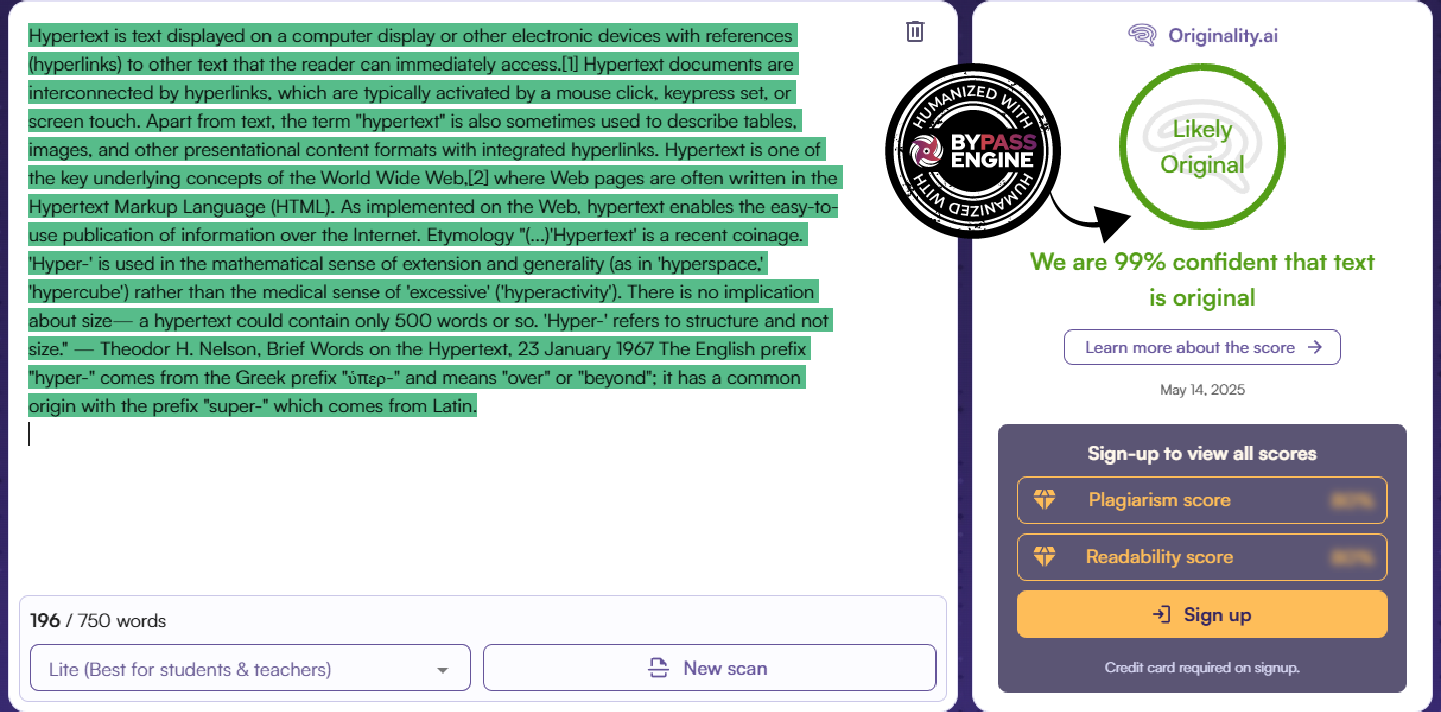
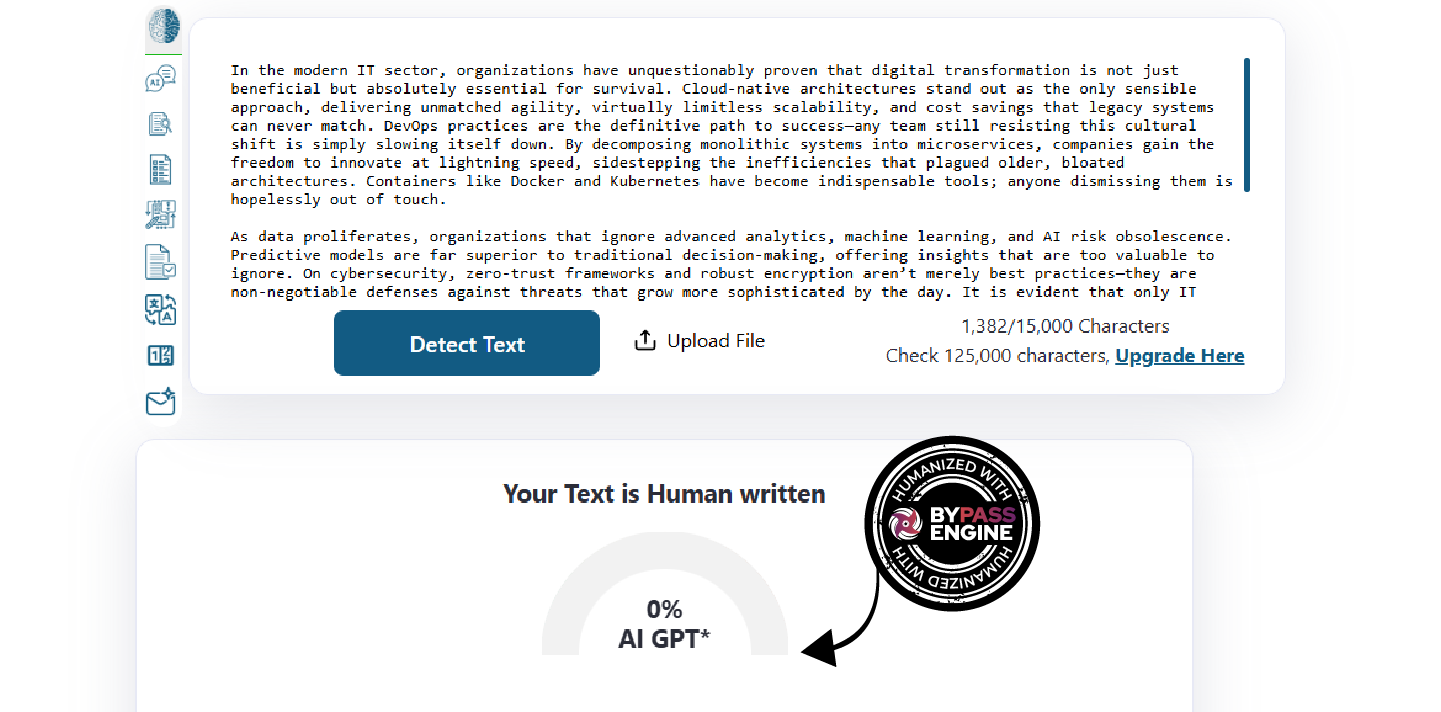
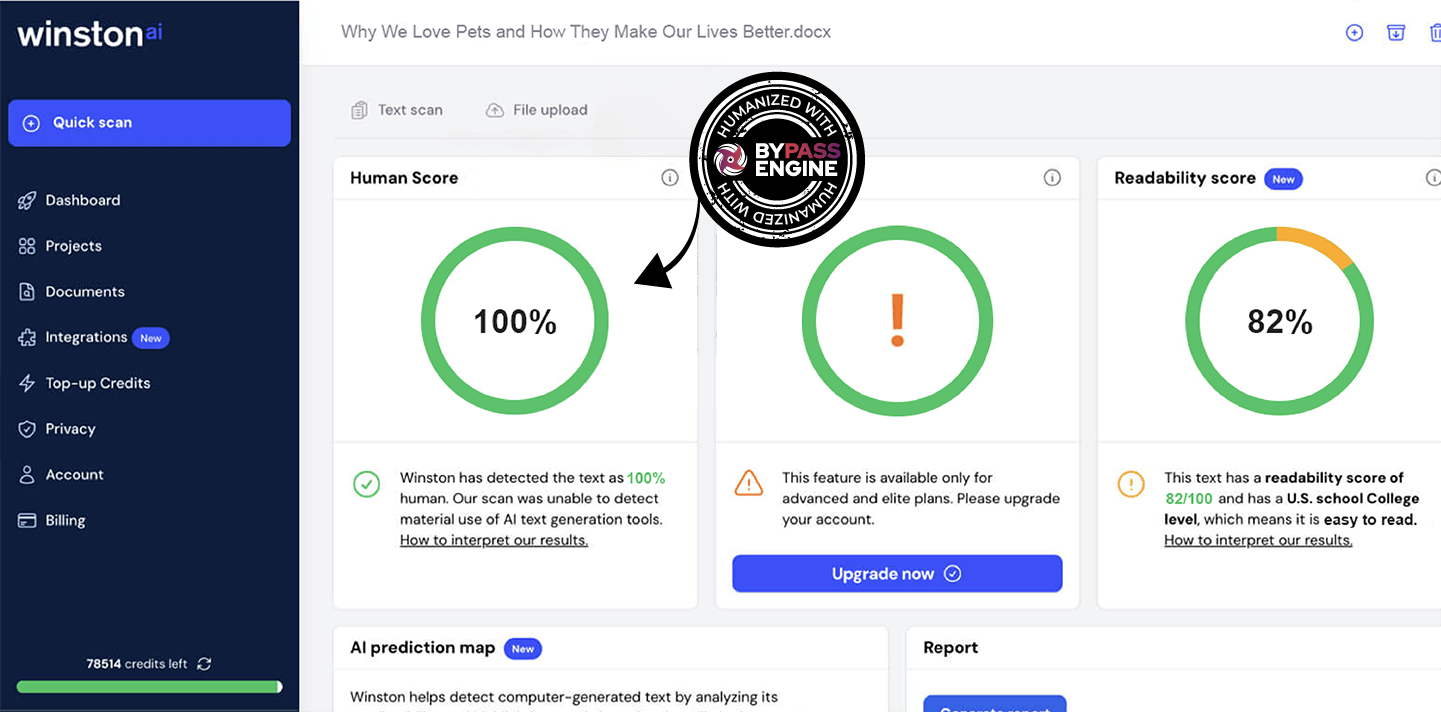
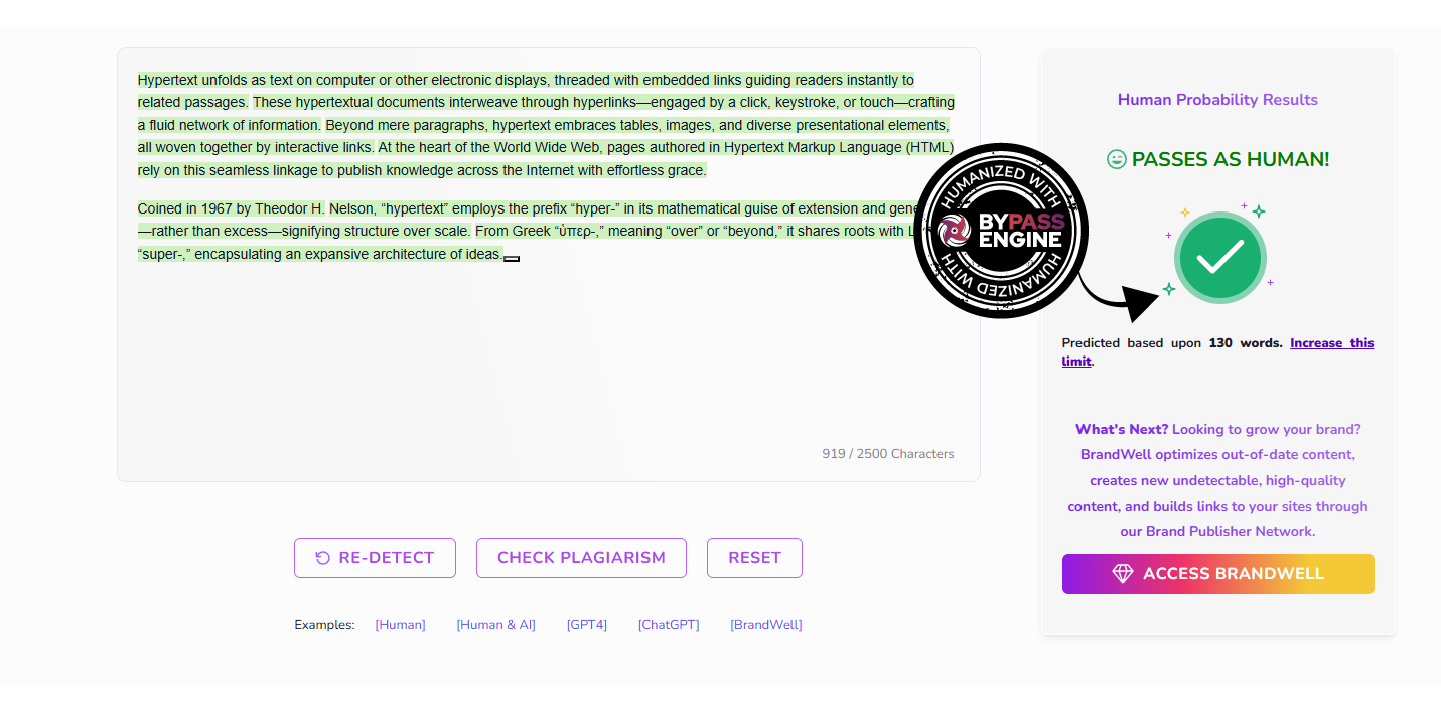
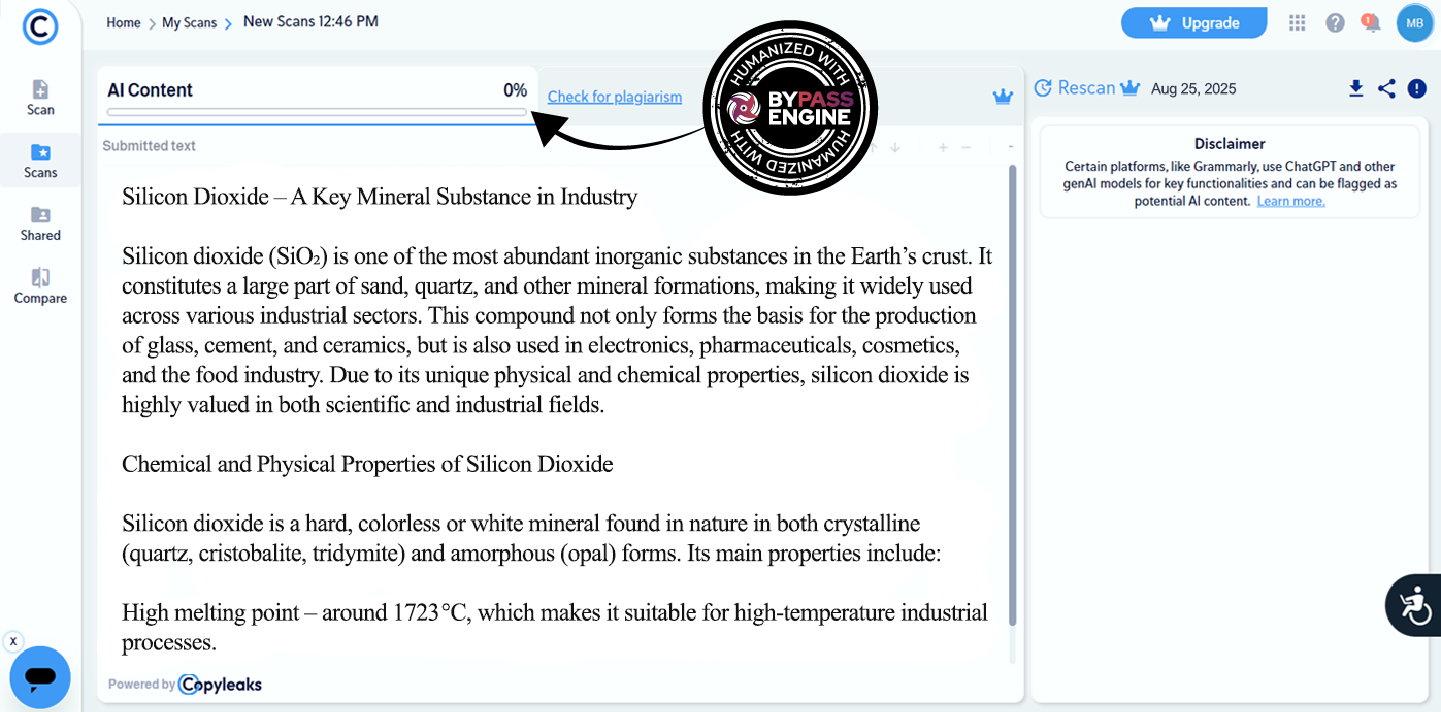
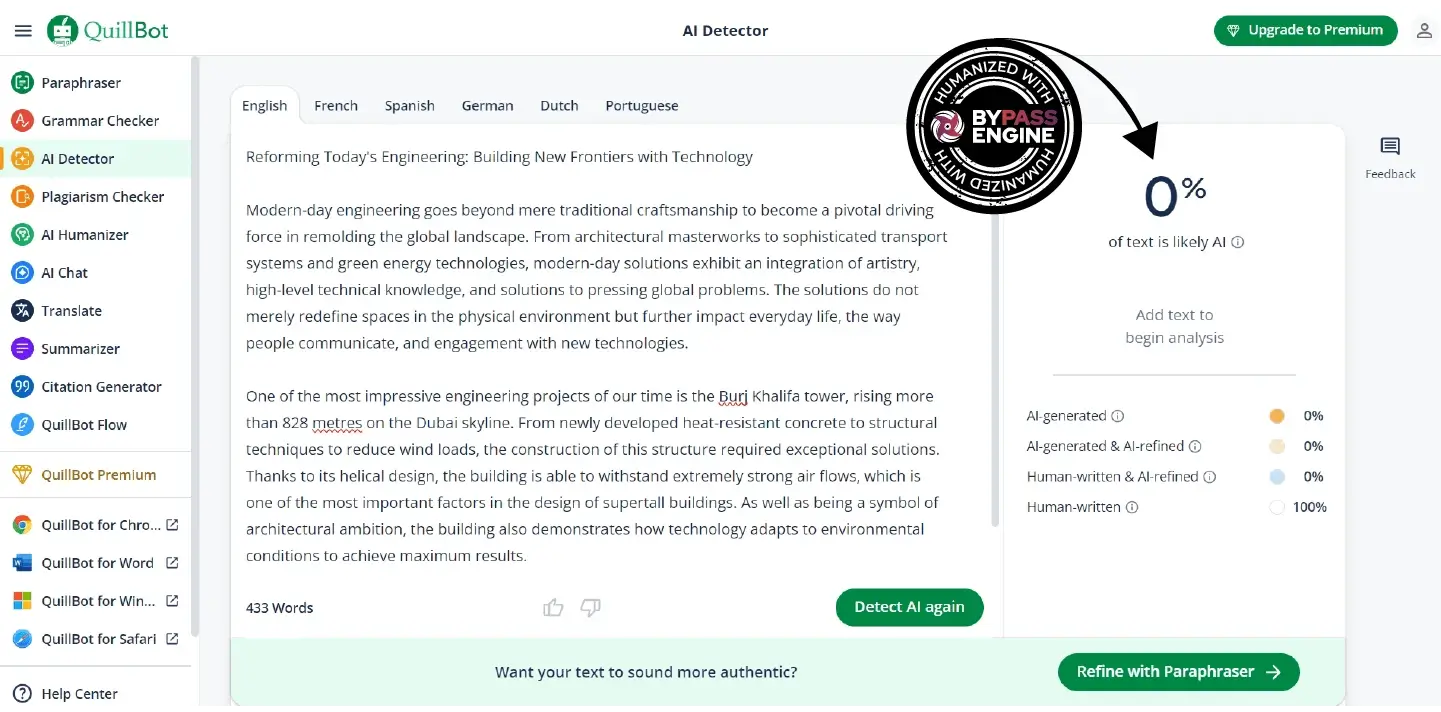
Try Bypass Engine – it’s on us!
You can use various AI models to check and improve your writing so it looks like people wrote it. Different tools help you make sure your document feels natural and real. This gives you confidence before you turn in your work, whether it’s for school, a job, or publishing.


by Veronica
I was skeptical at first, but after testing...
I was skeptical at first, but after testing it against Originality.ai and GPTZero, BypassEngine’s AI Detection Remover tool consistently passed. Now I use it for all my website.
by Ethan
As an SEO, I need content that ranks but...
As an SEO, I need content that ranks but isn’t AI detectable. This AI Detection Remover tool hits the mark. My clients have no idea. Worth every penny.
by John J.
I used to stress over my essays getting flagged...
I used to stress over my essays getting flagged as AI-written, even when I did most of the work myself. BypassEngine’s AI Detection Remover helped me avoid plagiarism in my drafts.
by Neil P.
My professor flagged my thesis draft...
My professor flagged my thesis draft as 60% AI-generated but t wasn’t. Bypass Engine remade my paper and my professor never suspected a thing.
by Luke Phillips
Running 10 Shopify stores means creating...
Running 10 Shopify stores means creating a lot of product descriptions. AI speeds things up, but Google penalizes it. BypassEngine AI Detection Remover tool paraphrase everything in a natural tone.
by Roger.
I’ve tried every bypasser out there...
I’ve tried every bypasser out there—StealthWriter, UndetectableAI & many others. Most just swap words awkwardly. AI Detection Remover rephrases my sentences like a real editor would!
for
students
Rewrite essays to bypass Turnitin and other detectors with ease.
for
marketers
Produce AI-assisted content that ranks without being flagged
for
researchers
Test AI detectors and generate untraceable academic summaries
for
copywriters
Transform AI drafts into content that feels written by you
for
developers
Transform AI drafts into content that feels written by you
for
journalists
Convert AI-generated notes into natural, publishable prose
for
authors
Polish AI-generated ideas into narrative-quality writing
for
AI research
Benchmark AI detectors using advanced bypass scenarios
95% of users content can be flagged with ai if AI Detection Remover is not used.
Secure Payment:
Bypass Engine AI bypasser has helped a lot of students and professionals to optimize their workflow, be productive and get the most out of their time while achieving their goals.
Our tool not only helps you get past AI content detectors, but it also shows you how it works. We highlight each change made in your text, so you see adjustments in grammar, phrasing, and structure. This makes the tool great for rewriting and learning.
By checking these edits, you learn how to better your writing. You’ll see patterns in tone, word choice, and clarity that make your content sound natural and human. Over time, this helps you become a more confident writer, whether it’s for essays, blogs, or work content.
Simply put, it’s more than a bypass tool—it’s a smart way to boost your writing skills.
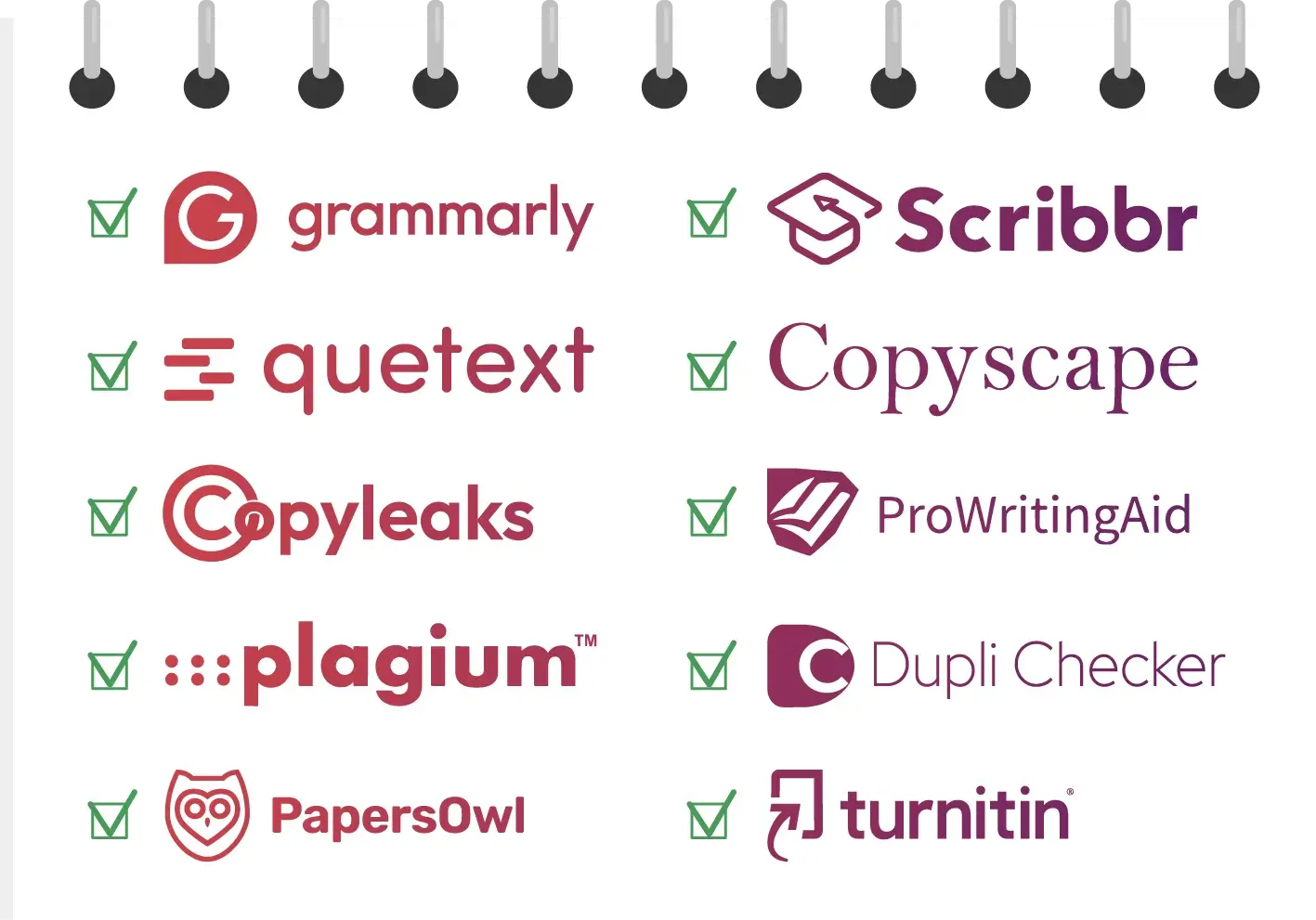


Bypass Engine’s AI content cleaner uses cutting-edge methods and technology to make your content sound natural and human-like. It grasps the context and keeps your intended message intact while reshaping your content.

Bypass Engine is a multilingual AI Detection Remover utility that rephrases essays and sentences across languages.
It supports 85 languages, including: Mongolian, Uzbek, Portuguese, Bashkir, Hindi, Kashmiri, Maithili, Romanian, Estonian, Welsh, Urdu, Oriya, Lithuanian, Hungarian, Kannada, Chinese, Pashto, Azerbaijani, Marwari, French, Belarusian, Slovene, Greek, English, Min Nan, Punjabi, Kyrgyz, Chhattisgarhi, Russian, Javanese, Vietnamese, Galician, Croatian, Dogri, Norwegian, Bengali, Armenian, Kazakh, Irish, Slovak, Finnish, Rajasthani, Catalan, Japanese, Serbian, Haryanvi, Awadhi, Santali, Danish, Faroese, Konkani, Bhojpuri, Brazilian Portuguese, German, Indonesian, Bashkir, Albanian, Montenegrin, Ukrainian, Maltese, Georgian, Malayalam, Macedonian, Arabic, Basque, Persian, Mandarin, Moldovan, Mandarin Chinese, Bosnian, Sinhala, Sindhi, Italian, Latvian, Sanskrit, Dutch, Korean, Czech, Malaysian and many more.

AI tools look at text to see if AI wrote it. They are trained with huge amounts of data. They notice patterns that are common in AI writing, like certain words, repeated phrases, and similar sentence structures. These tools use their training to find small hints that show if text is written by a person or by AI.
Bypass Engine’s AI content remover shines for many reasons:
-It’s affordable and comes with extra tools driven by AI to make your writing sound more genuine and real.
-It finds AI-written text fast and changes it in moments.
-It keeps up with AI writing tool updates, making sure it works well as detection ways change.
To lower the risk of AI marking your work as copied, try these tips:
-Include personal stories, real examples, or numbers to make your writing sound more human.
-Use a tool to help rewrite and improve your text before you turn it in.
-Try changing how you say things by rewording, shortening, or changing the sentence order.
-Don’t use the same words or phrases too much.
Bypass Engine’s AI Remover is different because:
-It’s free and doesn’t need you to sign up or give credit card details.
-You can pick from various AI models to fit what you want.
-It offers a complete set of AI tools to help improve your content.
-It keeps up with new AI writing trends to effectively spot and erase AI patterns.
Bypass Engine’s tool is useful in many areas:
Students: Schools are now using software to check if assignments are written by AI. If you turn in AI-created work, you might face trouble at school, even if it’s good. This tool changes how you write to make it look like a person wrote it. It tweaks words, tone, and structure to seem natural. This way, your work is more likely to follow school rules, pass checks, and keep you honest.
Writers: Writers, journalists, and content creators sometimes get wrongly flagged by AI detectors, even if their work is all theirs. These mistakes can cause extra checks, harm trust, or slow down publishing. This tool tweaks your text to sound more like it’s written by a person, cutting down the chances of it being marked as AI-made. This way, it keeps your reputation safe and helps your work go ahead smoothly.
Yes, using Bypass Engine’s AI detection remover is ethical. It pinpoints where your writing may appear too robotic and offers you the opportunity to enhance it. Plus, it safeguards your reputation from incorrect AI flags—even if you didn’t use AI tools to start.
This tool boosts your content by tweaking the tone, layout, and wording so it looks more like real human writing. It lowers the risk of AI detectors mistakenly flagging it and helps your work seem genuine. This is crucial in places like schools, jobs, and publishing, where being original and credible matters a lot.
Yes, it works great for professional tasks. Whether crafting articles, marketing materials, or reports, it helps your writing sound human. This way, your work flows naturally and avoids being flagged by AI systems that might wrongly identify it as not original.
Yes. The tool has an interface that’s simple to use, needing no tech know-how. Users just paste their text, make the suggested tweaks, and get a refined, human-sounding result in moments—perfect for students, teachers, and professionals too.
The tool is great for many types of written work, like essays, blog posts, research summaries, and product descriptions. It’s especially good at making text sound more natural and human, whether it was created with AI or just needs a touch of originality.
Yes, Bypass Engine respects your privacy. It handles all user data and content securely, ensuring nothing is stored or shared. Your work is treated with strict confidentiality throughout the process.
Here's a simple way to make your content sound more human with Bypass Engine’s tool:
1. Copy and paste the part of your text that might have AI-generated content. You can also upload your document in .doc, .docx, or .pdf formats.
2. Choose what you want the tool to do. Options include:
- AI detection: Modify the text to avoid AI content detectors.
- Experimental: Apply our new AI model to clear AI-generated text.
- Uniqueness: Change the text to prevent AI plagiarism issues, making it unique.
3. Click the Recreate button to improve your text and erase any signs of AI tool usage.
Afterward, you can download the revised document as a .pdf or .doc/.docx file. It includes an AI Plagiarism Checker to ensure your content is original.
Begin with content that is strong, clear, and correct in grammar—this is key to good writing. When your original message is easy to understand and well-organized, it’s simpler to rewrite it without changing the main idea. This method makes sure that even after you make changes—like for style or to get past AI detectors—the main point stays strong and clear. Simply put, writing clearly lets you make changes while keeping your original message powerful.
Our tool helps hide typical AI content traits well, making your writing seem genuine. But for top results, you should check the revised text closely. Ensure it flows well, matches your intent, and presents the facts or ideas you wish to share. By spending a bit of time to adjust and make the output your own, you can boost clarity, keep it consistent, and create quality content that sounds like your voice.
Running the text through a tool several times can greatly lower the chance of it being flagged as AI-made. Each run helps remove patterns that detectors usually spot, making the writing seem more natural. To get the best outcome, keep refining and checking the text until it flows well and matches your desired tone. A few careful changes can be key to making your writing truly yours.
Worried that your writing might seem like it was made by AI, even when you did it yourself? You’re not the only one. Sometimes, AI detectors can wrongly tag real work, and that’s both annoying and unfair. That’s why we have the AI Content Cleaner. It tweaks your text so it sounds natural and gets past AI checks easily. Whether it’s for school, work, or fun, our tool makes sure your writing is seen as yours. Try it now to keep your writing safe, real, and unnoticed!
AI content detection scans text. It identifies parts made by machines. This process checks if an AI wrote it. Why does this matter? It guards authenticity.
First, AI detection protects trust. Readers want real voices. Authenticity builds bonds. When people know a human wrote it, they feel connected. AI content detection helps keep this trust.
Second, it stops misuse. Some misuse AI to create misleading text. Detection finds this. It stops false info from spreading. In news and education, truth is vital.
Third, detection supports fair credit. Writers deserve recognition. If AI creates content, it changes who should get credit. Detection ensures fair compensation. Creators get what they earn.
Finally, it shapes AI ethics. As AI grows, ethical use is key. Detection helps guide AI use. It sets rules for when and how we use AI.
In summary, AI content detection is important. It protects trust, stops misuse, ensures fair credit, and guides ethics. It keeps the digital space honest and fair.
AI content detection removers function in clever ways. These tools alter text to avoid detection by AI systems. First, they identify patterns that AI detectors look for. These patterns may include repetitive phrases or specific word choices. Next, the removers modify the text. They do this by swapping words with synonyms or rearranging sentence structures. This keeps the main idea but changes the wording enough to slip past detectors.
Moreover, these tools employ techniques like text scrambling. They insert extra spaces or characters that don’t alter the meaning but confuse detectors. Some even adjust the text’s metadata, such as changing file names or formats, to further disguise the content. This makes it harder for AI systems to spot any flagged content.
One key feature is the use of randomness. Content removers introduce random elements or slight changes throughout the text. This randomness breaks up patterns that AI might detect as suspicious. Additionally, these tools continually learn and adapt. They analyze new AI detection methods and update their strategies to stay ahead.
In short, AI content detection removers use a blend of linguistic tricks and technological savvy. They dissect how AI systems work and then craft ways to outsmart them. This ongoing game of cat and mouse keeps the technology evolving, ensuring content slips through unnoticed.
AI content detection removal is not just about technology; it’s about making the right choices. It involves understanding ethics and law. Why? Because content online can spread fast, impacting people and society quickly. So, using AI to detect and remove content isn’t just a technical action—it’s a moral one too.
First, think about ethics. Content removal raises questions. What is right or wrong? Who decides this? AI can make mistakes. It can remove content unfairly. It might suppress free speech. So, it’s important to balance removing harmful content and protecting free expression. The goal is clear rules and transparency. This way, people know why content is removed.
Next, consider legality. Laws about content vary. What is legal in one place might not be in another. AI tools must respect these differences. They should follow local laws. This means working with legal experts. Also, privacy laws matter. AI must not misuse personal data. It should protect user privacy.
In conclusion, AI content removal is complex. It requires understanding both ethics and law. Developers must be careful. They need to ensure AI tools are fair and lawful. This way, AI can help create a safer online space without overstepping. Balancing these aspects is key. It builds trust and ensures AI serves everyone well.